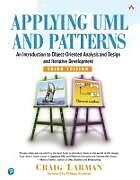Applying UML and Patterns
Einband:
Fester Einband
EAN:
9780131489066
Untertitel:
An Introduction to Object-Oriented Analysis and Design and Iterative Development
Genre:
Programmiersprachen
Autor:
Craig Larman
Herausgeber:
Prentice Hall
Auflage:
3rd ed
Anzahl Seiten:
703
Erscheinungsdatum:
30.11.2004
ISBN:
0131489062
Foreword.Preface.I. INTRODUCTION.1. Object-Oriented Analysis and Design. What Will You Learn? Is it Useful? The Most Important Learning Goal? What is Analysis and Design? What is Object-Oriented Analysis and Design? A Short Example. What is the UML? Visual Modeling is a Good Thing. History. Recommended Resources.2. Iterative, Evolutionary, and Agile. What is the UP? Are Other Methods Complementary? What is Iterative and Evolutionary Development? What About the Waterfall Lifecycle? How to do Iterative and Evolutionary Analysis and Design? What is Risk-Driven and Client-Driven Iterative Planning? What are Agile Methods and Attitudes? What is Agile Modeling? What is an Agile UP? Are There Other Critical UP Practices? What are the UP Phases? What are the UP Disciplines? How to Customize the Process? The UP Development Case. You Know You Didn't Understand Iterative Development or the UP When. History. Recommended Resources.3. Case Studies. What is and isn't Covered in the Case Studies? Case Study Strategy: Iterative Development + Iterative Learning. Case One: The NextGen POS System. Case Two: The Monopoly Game System.II. INCEPTION.4. Inception is Not the Requirements Phase. What is Inception? How Long is Inception? What Artifacts May Start in Inception? You Know You Didn't Understand Inception When... How Much UML During Inception?5. Evolutionary Requirements. Definition: Requirements. Evolutionary vs. Waterfall Requirements. What are Skillful Means to Find Requirements? What are the Types and Categories of Requirements? How are Requirements Organized in UP Artifacts? Does the Book Contain Examples of These Artifacts? Recommended Resources.6. Use Cases. Example. Definition: What are Actors, Scenarios, and Use Cases? Use Cases and the Use-Case Model. Motivation: Why Use Cases? Definition: Are Use Cases Functional Requirements? Definition: What are Three Kinds of Actors? Notation: What are Three Common Use Case Formats? Example: Process Sale, Fully Dressed Style. What do the Sections Mean? Notation: Are There Other Formats? A Two-Column Variation. Guideline: Write in an Essential UI-Free Style. Guideline: Write Terse Use Cases. Guideline: Write Black-Box Use Cases. Guideline: Take an Actor and Actor-Goal Perspective. Guideline: How to Find Use Cases. Guideline: What Tests Can Help Find Useful Use Cases? Applying UML: Use Case Diagrams. Applying UML: Activity Diagrams.&...
Autorentext
Craig Larman serves as chief scientist at Valtech, a leading technology consultancy with offices throughout the United States, Europe, and Asia. He is known throughout the worldwide software community as an expert and coach in OOA/D and design patterns, agile/iterative methods, an agile approach to the Unified Process (UP), and modeling with the UML. He holds a B.S. and M.S. in computer science from Simon Fraser University in Vancouver, British Columbia.
Klappentext
Craig Larman again delivers a clear path for students to learn object-oriented analysis and design through his clear and precise writing style. Larman teaches newcomers to OOA/D learn how to "think in objects" by presenting three iterations of a single, cohesive case study, incrementally introducing the requirements and OOA/D activities, principles, and patterns that are most critical to success.
Inhalt
I. INTRODUCTION. 1. Object-Oriented Analysis and Design. 2. Iterative, Evolutionary, and Agile. 3. Case Studies. II. INCEPTION 4. Inception is Not the Requirements Phase 5. Evolutionary Requirements. 6. Use Cases 7. Other Requirements. III. ELABORATION ITERATION 1-BASICS 8. Iteration 1-Basics 9. Domain Models 10. System Sequence Diagrams 11. Operation Contracts 12. Requirements to Design-Iteratively 13. Logical Architecture and UML Package Diagrams 14. On to Object Design 15. UML Interaction Diagrams 16. UML Class Diagrams 17. GRASP: Designing Objects with Responsibilities 18. Object Design Examples with GRASP. 19. Designing for Visibility 20. Mapping Designs to Code 21. Test-Driven Development and Refactoring IV. ELABORATION ITERATION 2-MORE PATTERNS 22. UML Tools and UML as Blueprint 3. Quick Analysis Update. 24. Iteration 2-More Patterns. 25. GRASP: More Objects with Responsibilities. 26. Applying GoF Design Patterns. V. ELABORATION ITERATION 3-INTERMEDIATE TOPICS. 27. Iteration 3-Intermediate Topics. 28. UML Activity Diagrams and Modeling. 29. UML State Machine Diagrams and Modeling. 30. Relating Use Cases. 31. More SSDs and Contracts. 32. Domain Model Refinement. 33. Architectural Analysis. 34. Logical Architecture Refinement. 35. More Object Design with GoF Patterns. 36. Package Design. 37. UML Deployment and Component Diagrams. 38. Designing a Persistence Framework with Patterns. 39. Documenting Architecture: UML & the N+1 View Model. VI. SPECIAL TOPICS 40. More on Iterative Development and Agile Project Management. Recommended Resources. Bibliography. Glossary. Index.

Leider konnten wir für diesen Artikel keine Preise ermitteln ...
billigbuch.ch sucht jetzt für Sie die besten Angebote ...
Die aktuellen Verkaufspreise von 6 Onlineshops werden in Realtime abgefragt.
Sie können das gewünschte Produkt anschliessend direkt beim Anbieter Ihrer Wahl bestellen.
Loading...
Die aktuellen Verkaufspreise von 6 Onlineshops werden in Realtime abgefragt.
Sie können das gewünschte Produkt anschliessend direkt beim Anbieter Ihrer Wahl bestellen.
| # | Onlineshop | Preis CHF | Versand CHF | Total CHF | ||
|---|---|---|---|---|---|---|
| 1 | Seller | 0.00 | 0.00 | 0.00 |
